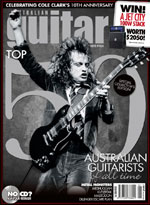SHREDDED METAL
OUTSIDE INSPIRATION
As guitar players we tend to spend a lot of time learning other famous guitarists songs, licks and solos. This can be a great way to expand your repertoire and progress as a musician. The only downside to this is that if you’re only ever copying other guitarists ideas you run the risk of just sounding like everyone else and not developing your own individuality. A great source of new ideas and inspiration is to look at music composed and performed on instruments other than guitar. Swedish virtuoso Yngwie Malmsteen is a prime example of this, using classical violin and the music of Bach and Paganini to help create his unique style and incredible vibrato. Another example is jazz fusion master Allan Holdsworth who drew inspiration from jazz saxophone players such as John Coltrane and Charlie Parker. Former Megadeth guitarist Marty Friedman has sought to emulate the vibrato and vocal phrasing of Japanese pop singers!
My point is that there is a wealth of other music and instruments out there which – when applied to the guitar – can be an excellent way to find your own voice. Learning music written for different instruments can also be good if you’re stuck in rut and need fresh ideas. It’s also a great way to improve your overall level of musicianship – whether this means using your ears to work things out, or by improving your sight reading and understanding of traditional music notation.
From a personal perspective, when I was young I learnt classical piano for ten years. As I progressed on the keyboard, I found myself drawn to the solo piano music of Frederic Chopin – particularly his etudes, nocturnes and waltzes. A few years ago, I thought it would be cool to see if I could learn and arrange one his famous pieces for the guitar.
EXERCISE 1
This is a short excerpt from Chopin’s Waltz in C Sharp Minor, Opus 64 Number 2. In 3/4 time, it is performed at a fast tempo and is quite a work out! When I was learning it, I had no one to look to for guidance. As such, I had to read the music and work out for myself the best fingerings and techniques to use. I ended up using alternate picking and upwards sweeps for the main repeated theme (bars 2-5 and 10-13). I also used hammer-ons/pull-offs for bars 6-9 (note the tricky string-skipping needed in these bars as well). There are no rules though, so if you’d like to give it a try, just use whatever techniques you feel comfortable with. For the final ascending run, the original line was outside the range of guitar, so I had to transpose it down an octave. Typical of the Romantic Era in which it was written, the piece should be performed with rubato (the slight slowing down or speeding up of the tempo).

Here's a demo I recorded of the full song – with the distorted guitar taking the right-hand piano part and the left-hand piano part played finger-style with a clean tone:
As a fan of Chopin’s music, I found learning one of his songs on the guitar to be a challenging, yet rewarding endeavour. Ultimately though, this was what worked for me. If solo piano isn’t your thing, there’s an abundance of other instruments to draw inspiration from. Give it try!



